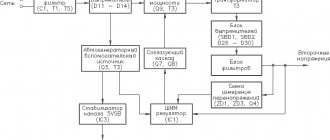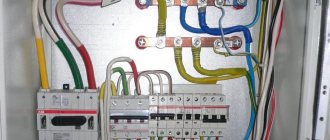Electrician in the house
Encyclopedia about electricity from A to Z
Masters catalog
Find the best master or company in your city
Correct marking of wires
Correct marking of wires and cords can greatly facilitate the installation and repair of any electrical networks. After all, correct marking will not only facilitate the installation process itself, but will also allow you or any other person to determine their purpose by simply looking at the junction box, panel or wires.
It is for these purposes that the marking of wires must be carried out in accordance with the uniform rules that are given in the “Bible” of any electrician - PUE (Electrical Installation Rules).
- Rules for marking live parts according to the PUE Color marking of wires
- Letter marking of wires
Why is labeling necessary?
Specific colors in electrics were not chosen by chance. Colored wiring is necessary for safe electrical work to avoid short circuits and electric shock. Previously, the color of conductors was black or white, which resulted in great inconvenience for electricians.
Previously, when disconnecting, it was necessary to supply power to the conductors, after which zero and phase were determined using control. Using coloring took all that pain away because everything became very clear.
Color coding is almost always applied along the entire length of the conductor. It helps to establish the assignment of each conductor to a specific group in order to facilitate their switching. There are three types of wires in electrics: phase, neutral and ground.
electrical safety
Alternating electric current with a voltage of 220 V or 380 V is dangerous for humans. Careless touching of exposed wires or metal parts of electrical equipment that may be live can result in severe burns or fatal injury. For this purpose, the PUE gives an answer to the questions: how the color of the wires phase and zero, L and N in electrics will help to clearly determine the security system used in a given electrical network.
Operation or work in a security zone
The rules for carrying out any work in a specific cable area are not particularly different for all types of pipelines, trunk and local networks. An organization or individual must find out in advance the location of the proposed venue for any events.
Section sketch
Advance approval must also be obtained. And no later than three days before the expected date in the cable security area. In the installation, reconstruction, and modernization of cable networks, compliance with SNiP 21-01-97 is mandatory.
Rules for marking live parts according to the PUE
To ensure clarity, simplicity and ease of recognition of individual parts of the electrical network, in accordance with clause 1.1.30 of the PUE, all electrical installations must have an alphanumeric and color designation. Moreover, the presence of one of these designations does not eliminate the need for the other.
Marking by color
Marking wires by color is the most visual and allows you to quickly determine the purpose of any wire. This marking can be done by selecting wires with the appropriate core insulation color, by applying paint to the busbars, or by painting or applying special colored tape at the core junctions.
Moreover, the paint on the tires may not be applied along the entire length, but only at the connection points or at the ends of the tires.
So:
- If we talk about the color designation of wires and cables, then we should start with the phase conductors. According to clause 1.1.30 of the PUE in a three-phase network, phase conductors must be marked in yellow, green and red. This is how phases A, B and C are designated respectively.
- The instructions for a single-phase electrical network suggest the designation of the phase wire in accordance with the color of which it is a continuation. That is, if a phase conductor is connected to phase “B” of a three-phase network, then it should be green.
Note! In a single-phase network in an apartment or house, you often do not know which phase your phase wire is connected to. In order to comply with GOST, you do not have to find out this at all. It is enough to designate the phase conductor with any of the proposed colors. After all, for a single-phase lighting network, it does not matter at all which phase your conductor is connected to. The only exception is the lighting network, which uses two different phase conductors.
- As for the neutral conductors, they should be blue in color. Moreover, the color of the neutral core does not depend on the three-phase, two-phase or single-phase network in front of you. It is always indicated in blue.
- Wire markings with a yellow-green stripe indicate a protective conductor. It is connected to the housing of electrical appliances and provides safety from electric shock if the insulation of electrical equipment is damaged.
- If the neutral and protective conductors are combined, then according to clause 1.1.29 of the PUE, such a wire core should have a blue color with yellow-green stripes at its ends. To make such markings with your own hands, you just need to take a blue wire and mark it with paint on its end seals or use colored electrical tape for this.
- As for DC networks, the positive core of a wire or bus should be indicated in red, and the negative core in blue. In this case, the designation of the neutral and protective conductors corresponds to the markings in alternating current networks.
Letter marking of wires
But color marking of wires is not always convenient. In switchboards, switchgears and on diagrams, the letter designation is much more convenient. It must be used in conjunction with the color designation.
So:
- The letter marking of phase wires in a three-phase network corresponds to their colloquial designation - phase “A”, “B” and “C”. For a single-phase network it should be the same, but this is not always convenient. Moreover, it is not always possible to reliably determine which phase exactly. Therefore, the designation “L” is often used. Clause 1.1.31 of the PUE standardizes not only the letter and color designation of conductors, but also their location. So for a three-phase network with vertical busbars, phase “A” should be the topmost, and phase “C” the bottom. And with a horizontal arrangement of conductors, the phase “C” closest to you should be, and the most distant phase “A”.
- If the wires are marked in the panel, then the symbol “N” indicates the neutral wire.
- The letter designation “PE” is used to designate the protective conductor. In addition, the grounding sign is often used, but the fact is that it cannot always accurately indicate the network diagram.
- The fact is that you may come across the designation “PEN”. It denotes the combination of the neutral and protective conductors. This is possible in TN-CS systems, which we discussed in one of our previous articles.
- But the marking of DC electrical wires is carried out with the symbolisms “+” and “¬―”. Which respectively means positive and negative wire. For direct current there is another difference. The zero core is designated by the symbol “M”, which is sometimes misleading.
Blog
With the help of this material, I want to help newcomers and old-timers understand and understand the features of color marking of wires and cables in accordance with the standards of the Republic of Belarus and not only.
Recently I had the opportunity to connect an apartment switchboard, which came with about 30 cables, with different color markings for the cores. The joke was that the markings were so different that each electrician (and there were two teams working at the site) interpreted the color markings in their own way.
Naturally, there were some problems, and in one day (as usual) I was not able to connect the shield, since my opinion on the color of the wires did not coincide with the opinion of other electricians. I had to spend another day to ring all the lines for proper connection in the switchboard.
I'll tell you the details...
Some of the most popular cables in Minsk (at the time of 2013-2015), made in accordance with GOST, were stretched to the shield. In the three-core cable VVG-P 3×1.5 and VVG-P 3×2.5, the colors of the cores are as follows:
- green + red + white
Next were the cables (Beltelekabel) with cores:
- white + white with black stripe + white with blue stripe,
- white + white with brown stripe + white with black stripe
There were also more pleasant, “correct” cables based on the colors of the cores (you’ll find out why they are correct a little later):
- yellow-green + blue + white
- yellow-green + blue + black
- yellow-green + blue + brown (although these were not VVG cables, but an installation PVS and a ShVVP cord, which should not be used in stationary electrical wiring, but that’s another story)
Before starting to understand the colors of the wires, I want to note the mistakes of electricians, from which I gained good experience.
Error 1. When performing electrical installation work, cables from different manufacturers with different core colors were used. At the same time, one color could be interpreted differently in different cable cores. For example, in one cable the zero is black, in another cable the ground is black*.
Error 2 . With wires of such different colors, the grounding and neutral conductors were not marked (using electrical tape or heat-shrink tubes). In simple words, you could simply wrap a piece of blue electrical tape around the core, which was taken as zero, and mark the grounding conductor with green-yellow electrical tape.
Error 3 . Another mistake does not relate to marking, but for some reason most electricians often make it. We are talking about a supply of cables for connecting shields. In this case, it is quite difficult to connect beautifully, since some cables are barely enough to connect. This is despite the fact that the connection was made using terminals on a DIN rail.
Never skimp on cable when connecting electrical panels! If you do not know at what height the shield will be installed, leave a cable reserve up to the floor (as I do). The excess cable can always be used as jumpers to connect sockets.
*Terms: ZERO (N) – working neutral conductor, EARTH (PE) – protective conductor
The conclusions I made when connecting the shield are very simple:
- I stopped using cables without green/yellow or blue markings for outlet lines and lighting power.
- Otherwise, I always mark the conductors with electrical tape to indicate ground (yellow-green tape), neutral (blue tape), and phase (red tape for single-phase wiring or yellow, green, red for three-phase wiring).
Somehow, I began to use the “AUTOWIRE” cable less and more, and “KOBRINAGROMASH” more and more. The colors of the latter are in perfect order.
Now let's understand the colors in electrical wiring.
Color marking of wires and cables in the Republic of Belarus
To begin with, you should understand that color marking is an excellent solution to quickly determine to any craftsman (electrician, engineer, power engineer, etc.) what role a particular conductor plays in an electrical installation. But the difficulty is that there is no single and exact rule for all countries and manufacturers.
In each country, the color marking of wires is different and may differ significantly from ours. In Russia, for example, there is so much confusion with regulations that they themselves do not know which rules to adhere to.
In the Republic of Belarus, there are national rules for the construction of electrical installations TKP 339-2011, which partially replaced some chapters of PUE 6. The following points can be found in it:
Let's take a look at the STB IEC 60173 standard, which is referred to in this paragraph:
I would like to draw your attention to four points in this standard:
- It is clearly defined that the yellow-green conductor is EARTH (PE)
- Blue color is ZERO (N)
- Recommended colors for other cores: BLACK or BROWN.
- Colors not recommended for cores: green, yellow, red, gray and white.
Let’s not draw further conclusions, and will continue to study TKP 339-2011:
Again, we are told that the grounding (protective) conductor must be GREEN-YELLOW and designated by the Latin letters PE.
From this point it is clear that ZERO (neutral conductor) should be indicated in BLUE.
And this item indicates what color the phase bars should be designated for a voltage of 400 (380) Volts:
- L1 (phase A) – YELLOW
- L2 (phase B) – GREEN
- L3 (phase C) – RED
We have familiarized ourselves with the paragraphs of TCH 339-2011 related to color marking. However, TKP 339-2011 only partially replaced some chapters of PUE 6. Everything else that is not in the technical code 339-2011 should be found in PUE 6, which is in force in the Republic of Belarus. And in it you can find the following paragraph 2.1.31:
The conclusions for now are simple:
1. On the territory of the Republic of Belarus there are rules for color marking of tires ( YELLOW , GREEN , RED ).
2. According to the colors of the wire cores:
GROUNDING (EARTH) PE – always YELLOW-GREEN
ZERO (neutral conductor) N – always BLUE (BLUE, LIGHT BLUE)
Advice
PHASE (phase conductor) L – can be black, brown, gray, red, purple, pink, white, orange, turquoise. However, it is recommended to use priority colors to designate phases: BROWN (priority for phase conductor No. 1) and BLACK (if there is a brown conductor, priority for phase No. 2).
Standard color coding of wires and busbars
Colored insulation of conductors today is an essential attribute for successful and correct installation of electrical wiring. This solution is by no means a way to make wires beautiful and attractive to the consumer; it is a convenient color marking, standardized and regulated throughout the civilized world, which is, without exaggeration, a necessity.
Color-coded wires provide precise identification of each conductor. The color of the core insulation determines its purpose in a group of several conductors and facilitates the switching and installation process.
This solution eliminates possible errors that could lead to fatal electric shock or short circuit. Electrical repairs and maintenance are also safer when wires are accurately marked.
The standard set out in the PUE strictly defines the colors of the markings, and thanks to this standard it becomes possible to easily identify each conductor, each cable core in a group by color or alphanumeric code.
As a rule, the entire conductor has a certain color, but it is also permissible to mark only the ends of individual cores at switching points where it is possible to use colored electrical tape or colored cambrics. Next, we will look in more detail at how exactly such marking is carried out for single-phase, three-phase and direct current networks.
For three-phase AC networks
In three-phase alternating current networks, high-voltage transformer inputs both at stations and substations, as well as busbars, are painted in the following colors, according to the phases:
- Phase “A” is colored yellow;
- Phase “B” is colored green;
- Phase “C” is colored red.
For DC networks
DC circuits are characterized by only two buses: positive and negative. Here the positive wire (positive charge bus) is marked in red, and the negative wire (negative charge bus) is marked in blue, because the neutral and phase wires are fundamentally absent here. The middle wire (M) is marked blue.
In the case where a dc network containing two conductors is created by branching from a three-wire dc circuit, the conductors are marked in the same way as the corresponding conductors of the original three-wire circuit.
Phase, neutral and ground in electrical wiring
AC electrical networks are now always laid with multi-core wires insulated with cores of different colors, this greatly simplifies the installation process. If the wiring in the room is carried out by one installer, and in the future other people will carry out maintenance and repair of the network, they will no longer be forced to constantly identify “phase” and “zero”, they will simply be guided by color.
But in the old days this was a real problem, because the insulation was one color - either white or black. Now a standard has been developed, and in accordance with GOST R 50462 “Identification of conductors by colors or digital designations”, the cores are separate and in cables have strictly regulated designations.
The function of marking is to create the ability to quickly and easily visually determine the purpose of each specific conductor for any section of it; this is one of the main requirements of the PUE. What colors, according to GOST, should conductors have in AC electrical installations for voltages up to 1000 volts and with a solidly grounded neutral, which includes almost all residential buildings and administrative buildings?
The neutral working conductor (N) is marked in blue. For the neutral protective conductor (PE) - yellow-green markings in the form of stripes along or across the core. This marking in the named color combination is relevant only for grounding conductors (for neutral protective conductors).
When the neutral working conductor is made combined with the neutral protective conductor (PEN), then along the entire length of the wire the marking is blue, and at the connection points (at the ends of the conductor) there are yellow-green stripes, or vice versa: a yellow-green conductor with blue ends.
Thus, neutral wires are marked with the following colors:
- Neutral working wire (N) – blue marking;
- Neutral protective conductor (PE) – yellow-green marking;
- Neutral combined wire (PEN) - yellow-green marking with blue marks at the ends or vice versa.
Phase wires, in accordance with the PUE standard, can be marked in one of these colors: red, black, purple, brown, gray, pink, orange, turquoise, or white. If a single-phase electrical circuit is obtained by branching from a three-phase network, then the phase wire of the resulting single-phase circuit must necessarily match the color of the original wire of the three-phase network from which the branch was made.
The wires are marked so that the colors of the phase wires in no way match the color of the neutral conductor. And if an unmarked cable is used, then color marks are made at the ends of the cores, at the joints, using heat-shrink tubes or colored electrical tape. But to prevent unnecessary work on making tags, it is enough to initially choose the right insulation color, choosing a cable of sufficient length for your needs.
Sometimes an electrician at work has to deal with not very pleasant situations when the wiring has already been done, and neither the connections in the panel nor the wires are marked, in this case the person has to waste time and, using a probe, identify “phase”, “zero”, and "grounding".
However, you should always remember that even if it is not possible to purchase a wire of the desired color, you can, of course, use a wire of any color, but then you must definitely mark the ends of the wires with at least colored heat shrink or colored electrical tape. And always remember to be careful when installing electrical wiring and always follow safety precautions.
HOW TO DETERMINE PHASE AND ZERO
Where is the phase, where is the zero - a question that arises when connecting any electrical device.
First, let's look at how to find the phase. The easiest way to do this is with an indicator screwdriver (Figure 7).
With the conductive tip of the indicator screwdriver (1) we touch the controlled section of the electrical circuit (during operation, contact of this part of the screwdriver with the body is unacceptable!), with a finger we touch contact pad 3, the glow of indicator 2 indicates the presence of a phase.
In addition to an indicator screwdriver, the phase can be checked with a multimeter (tester), although this is more labor-intensive. To do this, the multimeter should be switched to AC voltage measurement mode with a limit of more than 220 Volts. With one probe of the multimeter (it doesn’t matter which one) we touch the section of the circuit being measured, with the other we touch the natural ground electrode (heating radiators, metal water pipes). When the multimeter readings correspond to the network voltage (about 220 V), there is a phase in the measured section of the circuit (diagram Fig. 8).
I draw your attention to the fact that if the measurements taken show the absence of a phase, it cannot be stated that this is zero. Example in Figure 9
- Now there is no phase 1 at point.
- When the switch S is closed, it appears.
Therefore, you should check all possible options.
I would like to note that if there is a grounding wire in the electrical wiring, it is impossible to distinguish it from the neutral conductor using electrical measurements within the apartment. As a rule, the wire used for grounding is yellow-green in color, but it is better to verify this visually, for example, remove the socket cover and see which wire is connected to the grounding contacts.
2012-2017 All rights reserved.
Wiring inside the house
Wiring inside the house is carried out only with single-phase lines and copper wires. In electrical circuits used for domestic purposes, the working zero should always be blue! According to the PUE, intra-house lines must be laid with a grounding conductor. In all three-core conductors made in accordance with GOST, suitable for interior work, the grounding wire is yellow-green.
If the three-core conductor is flexible PVA type, then the phase conductor is usually brown. For indoor wiring, it is better to use wires made of cast copper. If the conductors are marked with stripes, then a conductor with a stripe of any color except blue and yellow-green is phase.
If the cable does not have a yellow-green conductor, use a conductor with a green stripe as the ground wire. The ground wire may be marked in pure yellow. In cables whose cores are entirely painted, the white wire is the phase wire.
Connection to electric stove
A 220 V household electric stove is connected to a special outlet that can withstand high power. The colors of the conductors are red, green, blue, where red is the phase, green is the ground, blue is the neutral conductor.
There is a nuance: in foreign-made electric stoves and hobs designed for 220/380 V, the connection is made with a four-wire cable:
- blue – zero;
- yellow-green conductor – grounding;
- black conductor – phase A;
- brown conductor – phase B.
When connecting to a single phase network, it is allowed to combine the phase conductors on the electric stove under one contact clamp.
Neutral wire
The neutral conductor is the wire connected to the middle (null) point of the electrical system. In the standard connection diagram, this is a combined neutral working and neutral protective conductor in a three-phase circuit. The color of the neutral wire is all blue with yellow-green ends or all yellow-green with blue ends.
Wires are marked by color, letters and numbers. GOST until 2009 interpreted the possibilities of marking wires more broadly. Since 2009, the standards have been revised towards a more clear classification of colors and have eliminated notes that make it possible not to mark conductors.
The 2009 national standard clarified the terminology and expanded the alphanumeric classification. For electrical circuits until 2009, classic conductor colors were used: yellow, green, red.
In the classic version of three-phase circuits up to 1000 volts, conductors are marked in the following combinations:
- Phase A – L1, yellow – brown recommended.
- Black is recommended in phase B – L2, green.
- Phase C – L3, red – gray recommended.
- Neutral conductor – N blue.
- Combined working neutral with grounding conductor - PEN, blue with yellow-green tips - yellow-green with blue tips.
- Grounding conductor – PE, yellow-green.
This combination does not imply either the direction of rotation or phasing.
Neutral color
What color the neutral wire is is specified by GOST , therefore, when looking at the installation of a power plant, the question should not arise whether the blue wire is a phase or a zero, since the blue color and its shades (blue) are accepted to indicate neutral (working grounding).
Other colors of neutral cores are not permitted.
The only acceptable use of blue and cyan insulation is to indicate the negative pole or midpoint in DC circuits. This color cannot be used anywhere else.
Rules for observing the colors of electrical wiring during installation
A three-core or two-core wire is laid from the distribution box to the switch, depending on what type of switch is installed: a single-key or two-key switch. The phase is broken, not the neutral conductor. If there is a white conductor available, it will be the power supply. The main thing is to maintain consistency and consistency in coloring with other electricians, so that it doesn’t turn out like in Krylov’s fable: “The Swan, the Crayfish and the Pike.”
On sockets, the protective conductor (yellow-green) is most often clamped in the middle part of the device. We maintain polarity, zero worker is on the left, phase is on the right.
But there are surprises from manufacturers, for example, one conductor is yellow-green, while the other two may turn out to be black.
Perhaps the manufacturer decided, if there was a shortage of one color, to use what was available. Don't stop production! Failures and errors happen everywhere. If you come across exactly the same one, it’s up to you to decide where the phase is and where the zero is, you just need to run around with the control.
Checking the correct connection
Unfortunately, not all electricians strictly follow the standards and make mistakes in choosing a conductor when making connections. Therefore, when hanging a chandelier, installing a socket or other electrical installation device, it is better to additionally check whether the insulation of each core corresponds to its purpose.
For identification, installers use two methods: the first is checking with an indicator screwdriver, the second is using a tester or multimeter. The phase is usually determined with a screwdriver, and neutral and zero are determined with measuring instruments.
How to use the indicator?
Even such simple devices as indicator screwdrivers are different. Some of them are equipped with a small button, others are triggered automatically when a metal rod and a current-carrying conductor or contact are connected.
But all models without exception have a built-in LED that lights up under voltage.
A screwdriver is a convenient tool for identifying the phase conductor. To find out whether the wire is working, use the metal blade of a screwdriver to gently touch the exposed wire.
If the LED lights up, the wire is energized. The absence of a signal indicates that it is ground or zero.
The verification procedure is performed with one hand, therefore, the other is free. It is better to also use it - for example, to fix wires. But it is strictly forbidden to touch the exposed parts of conductors or metal objects located nearby (pipes, fittings) with your second hand.










